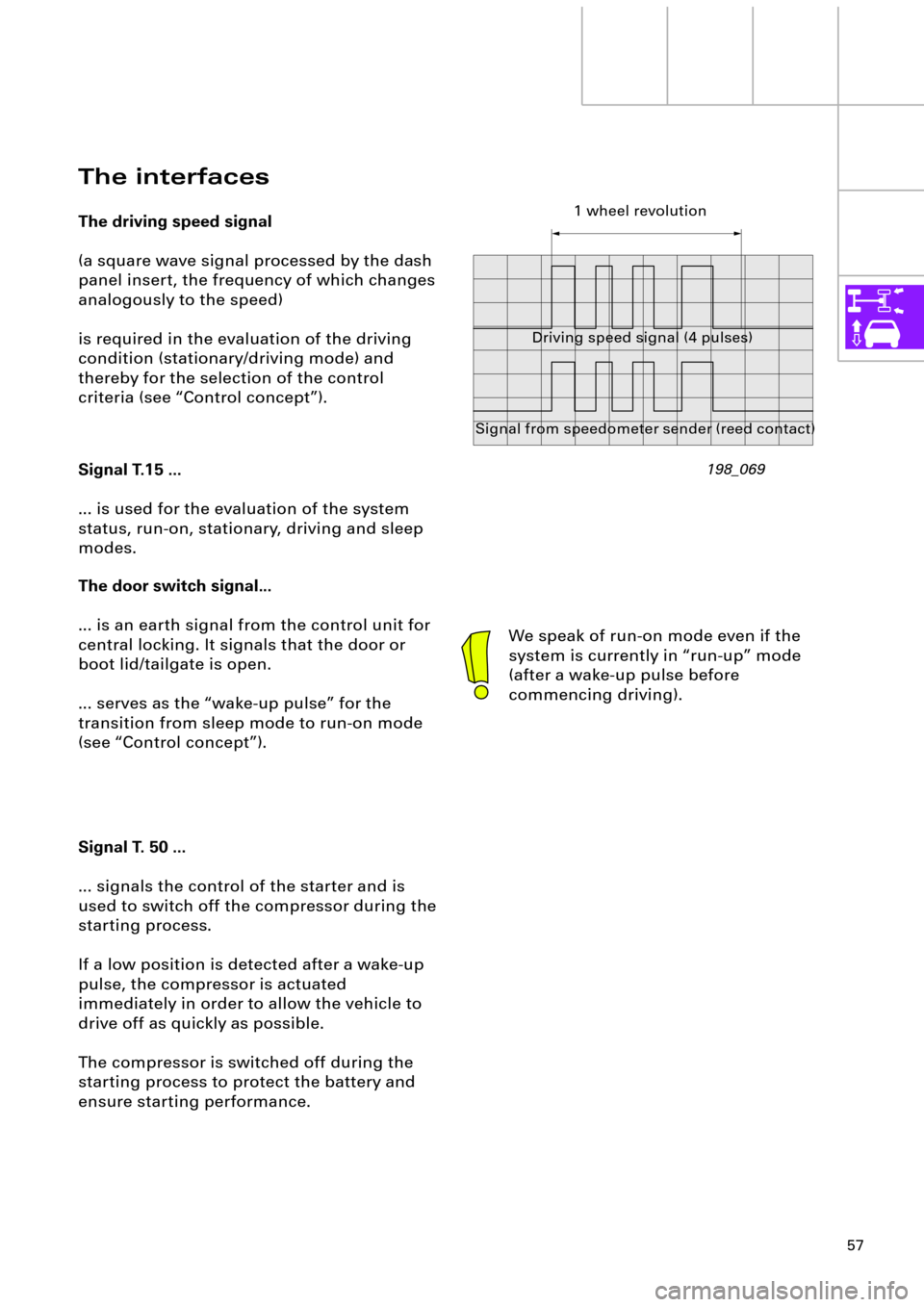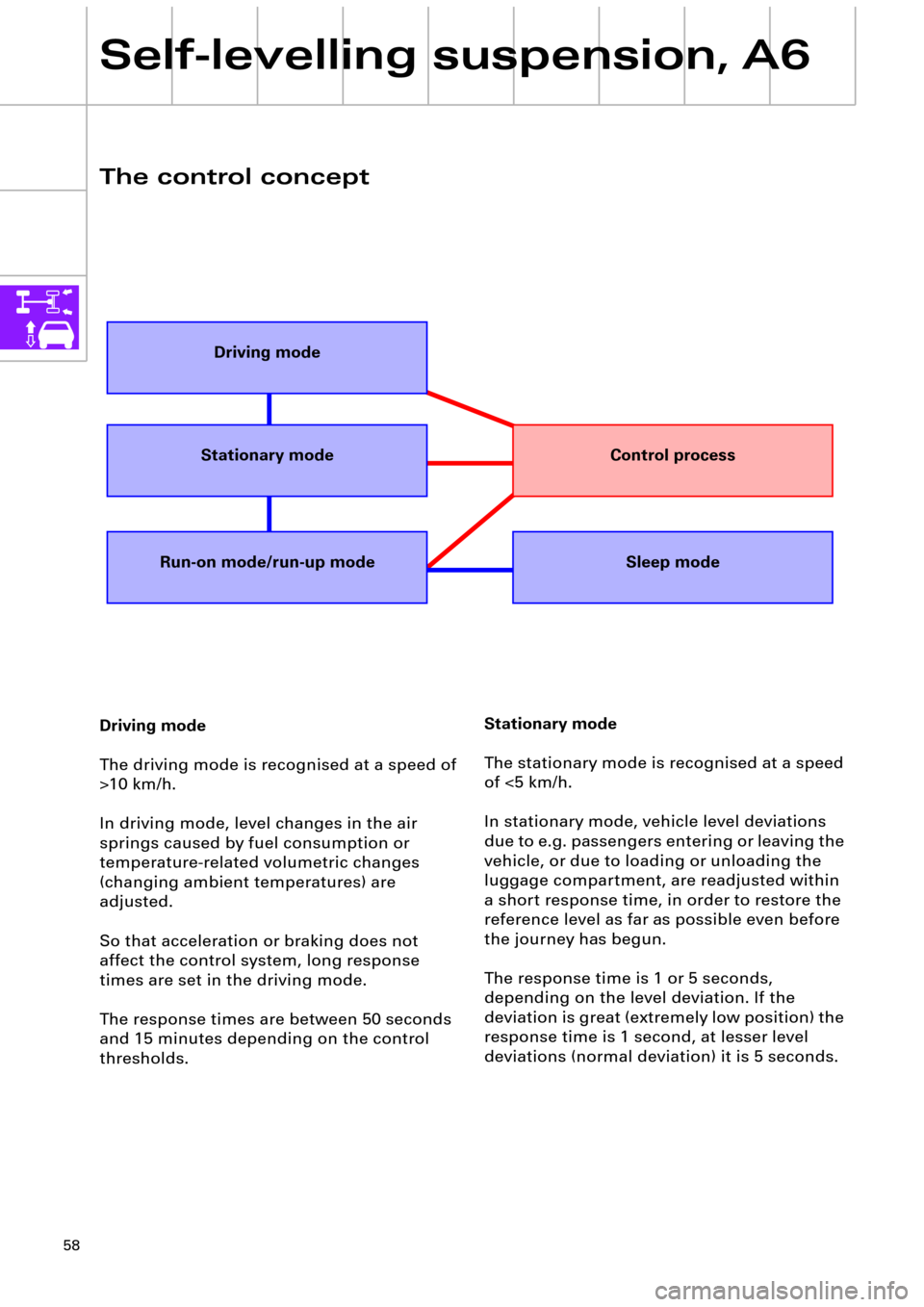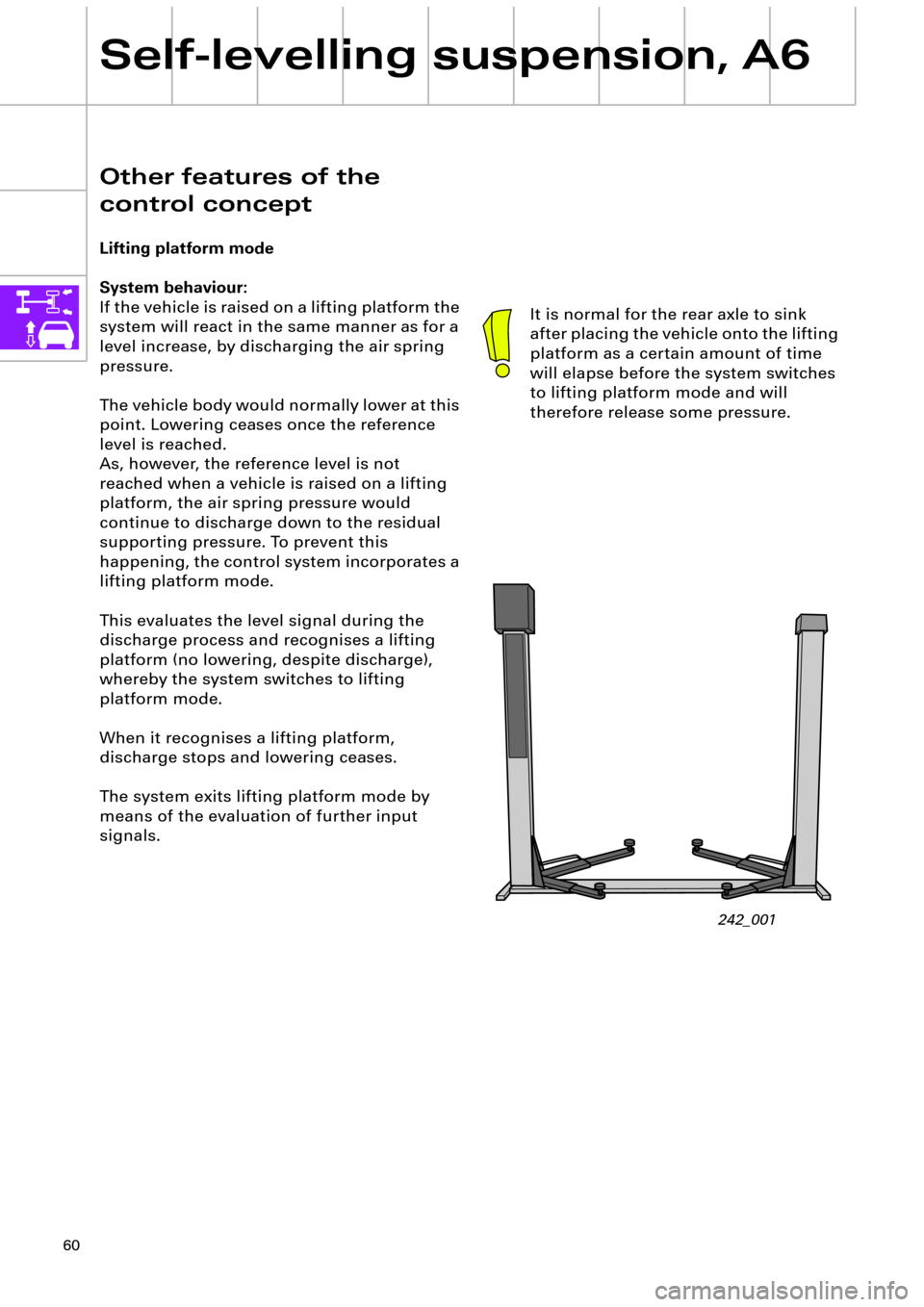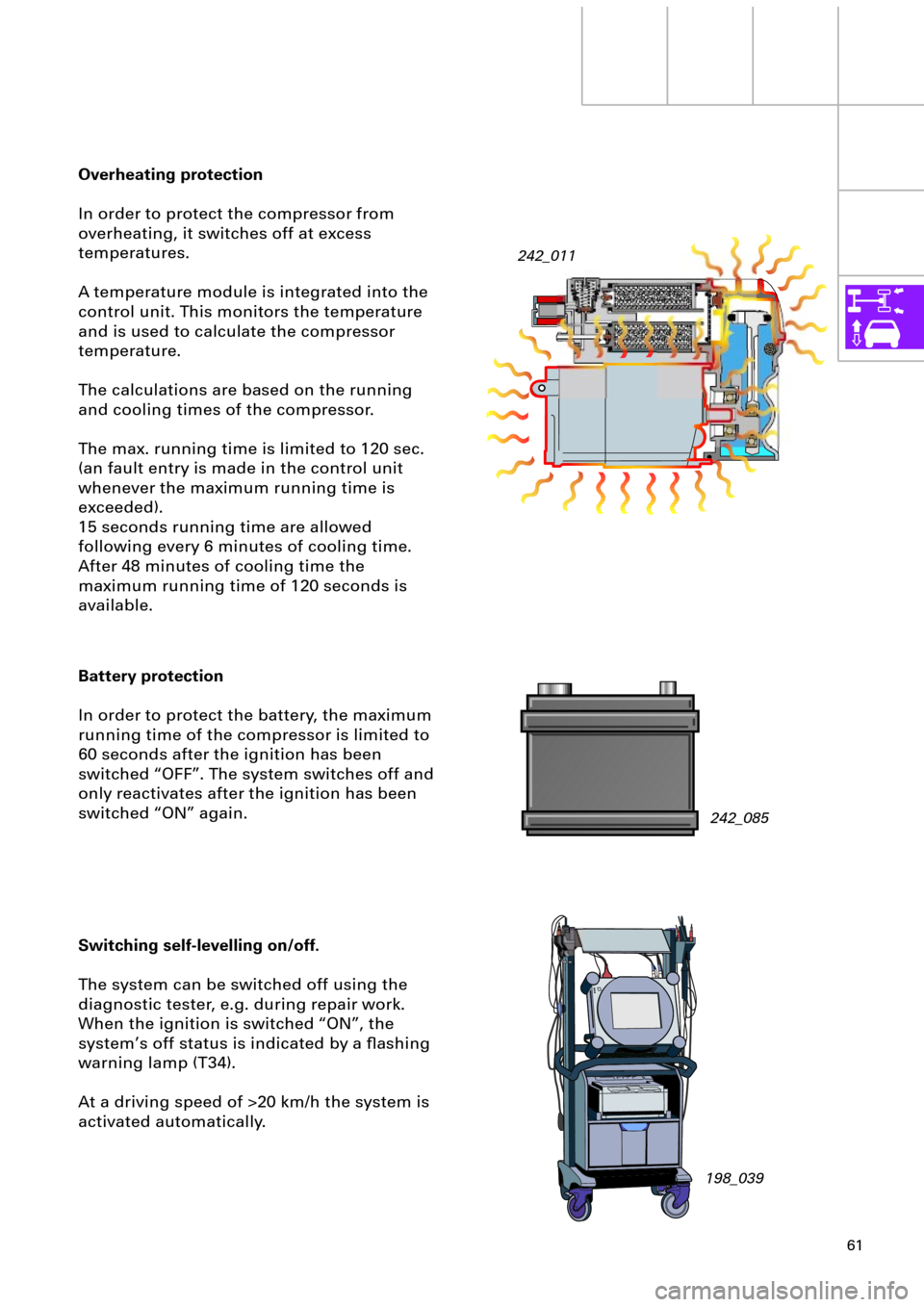Page 57 of 64

57
The interfaces
The driving speed signal
(a square wave signal processed by the dash
panel insert, the frequency of which changes
analogously to the speed)
is required in the evaluation of the driving
condition (stationary/driving mode) and
thereby for the selection of the control
criteria (see ÒControl conceptÓ). 1 wheel revolution
Signal T.15 ...
... is used for the evaluation of the system
status, run-on, stationary, driving and sleep
modes.
Signal T. 50 ...
... signals the control of the starter and is
used to switch off the compressor during the
starting process.
If a low position is detected after a wake-up
pulse, the compressor is actuated
immediately in order to allow the vehicle to
drive off as quickly as possible.
The compressor is switched off during the
starting process to protect the battery and
ensure starting performance. The door switch signal...
... is an earth signal from the control unit for
central locking. It signals that the door or
boot lid/tailgate is open.
... serves as the Òwake-up pulseÓ for the
transition from sleep mode to run-on mode
(see ÒControl conceptÓ).
Driving speed signal (4 pulses)
Signal from speedometer sender (reed contact)
We speak of run-on mode even if the
system is currently in Òrun-upÓ mode
(after a wake-up pulse before
commencing driving).
198_069
Page 58 of 64

58
Self-levelling suspension, A6
The control concept
Stationary mode
The stationary mode is recognised at a speed
of <5 km/h.
In stationary mode, vehicle level deviations
due to e.g. passengers entering or leaving the
vehicle, or due to loading or unloading the
luggage compartment, are readjusted within
a short response time, in order to restore the
reference level as far as possible even before
the journey has begun.
The response time is 1 or 5 seconds,
depending on the level deviation. If the
deviation is great (extremely low position) the
response time is 1 second, at lesser level
deviations (normal deviation) it is 5 seconds. Driving mode
The driving mode is recognised at a speed of
>10 km/h.
In driving mode, level changes in the air
springs caused by fuel consumption or
temperature-related volumetric changes
(changing ambient temperatures) are
adjusted.
So that acceleration or braking does not
affect the control system, long response
times are set in the driving mode.
The response times are between 50 seconds
and 15 minutes depending on the control
thresholds.
Driving mode
Stationary mode
Run-on mode/run-up modeSleep mode
Control process
Page 59 of 64

59
Sleep mode
To minimise electricity consumption the
control system switches to Òsystem idleÓ
(sleep mode) after 15 minutes.
There is no level adjustment in sleep mode.
ÒWake-upÓ is primarily triggered by the door
switch signal.
If the door switch signal fails, the system is
activated when the ignition is switched ÒONÓ
or by the driving speed signal.
The system can switch between sleep mode
and run-up mode, triggered by the door
switch signal, a maximum of 5 times. After
this, the system can only be activated via
terminal 15 and/or the driving speed signal. Run-on mode/run-up mode
After ÒIgnition OFFÓ, the control system is in
the so-called run-on/run-up mode. The
control unit remains active for a maximum of
15 minutes (via terminal 30) until it goes into
sleep mode.
The run-on/run-up mode is used to adjust
level deviations after parking the vehicle or
prior to starting on a journey.
The limit value in the rebound direction is
increased by 25 mm in the run-on/run-up
mode so that when the driver and/or the
passenger re-enters the vehicle, it does not
sink lower than the reference level or in order
to minimise any necessary vehicle raising
period.
The same response times apply as those
indicated for the stationary mode.
Page 60 of 64

60
Self-levelling suspension, A6
Other features of the
control concept
Lifting platform mode
System behaviour:
If the vehicle is raised on a lifting platform the
system will react in the same manner as for a
level increase, by discharging the air spring
pressure.
The vehicle body would normally lower at this
point. Lowering ceases once the reference
level is reached.
As, however, the reference level is not
reached when a vehicle is raised on a lifting
platform, the air spring pressure would
continue to discharge down to the residual
supporting pressure. To prevent this
happening, the control system incorporates a
lifting platform mode.
This evaluates the level signal during the
discharge process and recognises a lifting
platform (no lowering, despite discharge),
whereby the system switches to lifting
platform mode.
When it recognises a lifting platform,
discharge stops and lowering ceases.
The system exits lifting platform mode by
means of the evaluation of further input
signals.It is normal for the rear axle to sink
after placing the vehicle onto the lifting
platform as a certain amount of time
will elapse before the system switches
to lifting platform mode and will
therefore release some pressure.
242_001
Page 61 of 64

61
Overheating protection
In order to protect the compressor from
overheating, it switches off at excess
temperatures.
A temperature module is integrated into the
control unit. This monitors the temperature
and is used to calculate the compressor
temperature.
The calculations are based on the running
and cooling times of the compressor.
The max. running time is limited to 120 sec.
(an fault entry is made in the control unit
whenever the maximum running time is
exceeded).
15 seconds running time are allowed
following every 6 minutes of cooling time.
After 48 minutes of cooling time the
maximum running time of 120 seconds is
available.
242_011
Battery protection
In order to protect the battery, the maximum
running time of the compressor is limited to
60 seconds after the ignition has been
switched ÒOFFÓ. The system switches off and
only reactivates after the ignition has been
switched ÒONÓ again.
Switching self-levelling on/off.
The system can be switched off using the
diagnostic tester, e.g. during repair work.
When the ignition is switched ÒONÓ, the
systemÕs off status is indicated by a ßashing
warning lamp (T34).
At a driving speed of >20 km/h the system is
activated automatically.
198_039242_085
Page 62 of 64
Page 63 of 64
Page 64 of 64
Service.For internal use only All rights reserved, including
the right to make technical
changes.
AUDI AG
Dept. I/VK-5
D-85045 Ingolstadt
Fax 0841/89-36367
940.2810.47.20
Technical status 11/00
Printed in Germany
Pneumatic suspension system
Par t 1
Selflevelling suspension
in the Audi A6Design and Function
Self-study programme 242
242
242